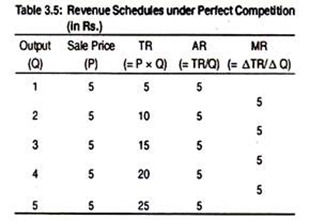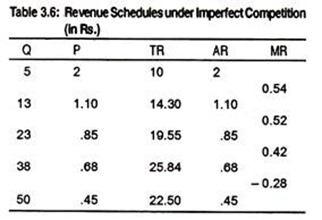The following points highlight the three important types of revenue concepts. The types are: 1. Total Revenue Concept2. Average Revenue Concept 3. Marginal Revenue Concept.
Revenue Concept: Type # 1.Total Revenue (TR):
A firm’s total revenue is the total receipt it gets from the sale of the product. Thus TR depends on the volume of sale. As sales change, TR changes. Thus,
TR = f (Q)
where Q is the quantity of output sold.
ADVERTISEMENTS:
However, TR resulting from the sale of a product depends on the price as well as the volume of goods sold:
TR = P × Q
So, TR is defined as equal to the price of the goods times the volume of goods sold.
Revenue Concept: Type # 2. Average Revenue (AR):
Average revenue is the revenue per unit of output sold. Dividing total revenue by the volume of output sold, one obtains AR.
ADVERTISEMENTS:
It is expressed as:
AR = TR/Q = P × Q/Q = P
Thus AR equals price, irrespective of the nature of the market. In other words, price line is identical to the AR curve. AR curve is the firm’s demand curve for a commodity since it expresses the relationship between price and quantity sold. Since the demand curve for the firm’s product also shows the same relationship, these two curves must be identical.
Revenue Concept: Type # 3. Marginal Revenue (MR):
MR is the extra revenue obtained by a firm from the sale of one extra unit of output. Suppose, a firm obtains Rs. 1,000 as revenue from the sale of 100 units of output. If the volume of sale increases to 110 units, its total revenue will go up to, say, Rs. 1,100. Thus, MR is Rs. 100.
ADVERTISEMENTS:
So, MR of the Q-th unit can be written as the difference between TR of Q-th unit of goods sold and TR of (Q – 1)th unit of goods sold:
MR = TR (Q) – TR (Q – 1).
It can also be defined as the change in total revenue consequent upon a change in goods sold:
MR = ∆TR/∆Q
The following two schedules help us in explaining the revenue concepts.
Table 3.5 shows TR, AR and MR of a firm operating under perfectly competitive conditions:
As price of the goods remains constant under perfect competition, TR increases proportionately as volume of sales increases. Here ruling market price is set by market forces of supply and demand. But, to an individual firm, price is fixed. That is why, price = AR = MR for all levels of output sold.
Table 3.6 shows TR, AR and MR of a firm under imperfect competition. A firm, under imperfect competition, can influence the price of the product that it wants to sell. Further, if it wants to sell more it will have to lower down price.
This schedule shows that as sales increase, TR increases. But TR declines when 50 units of goods are sold at a price of Rs. 0.45. So long as TR rises, MR declines.
Thus, MR can both be positive and negative at different levels of output. Note that, as output increases, AR declines. This means that if the seller wants to sell more he will have to reduce the price of his product. Further, Table 3.6 shows that AR exceeds MR at all levels of output.

